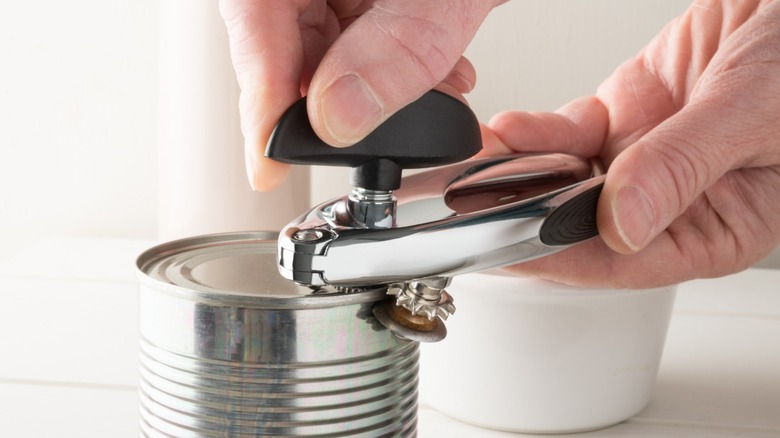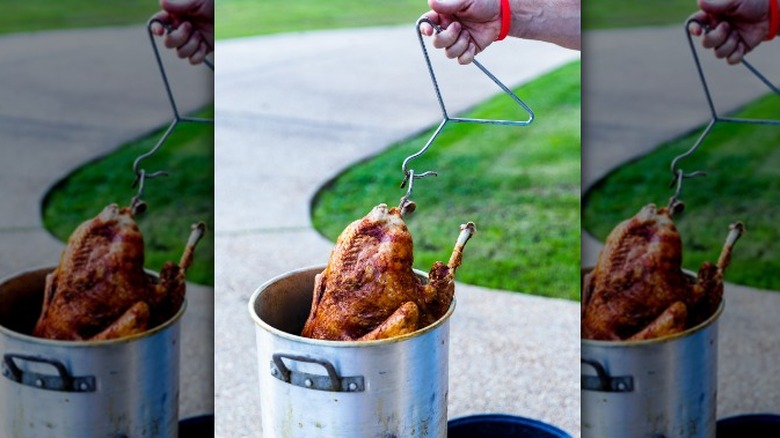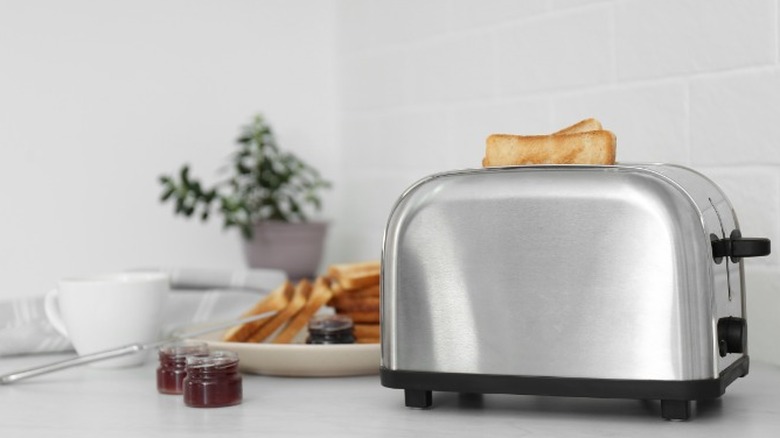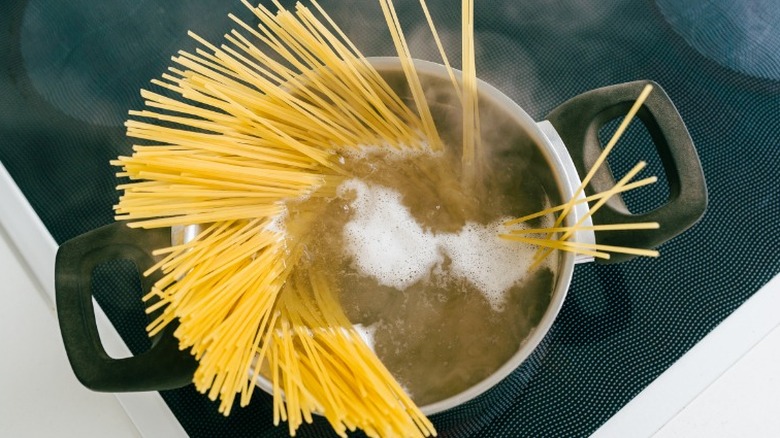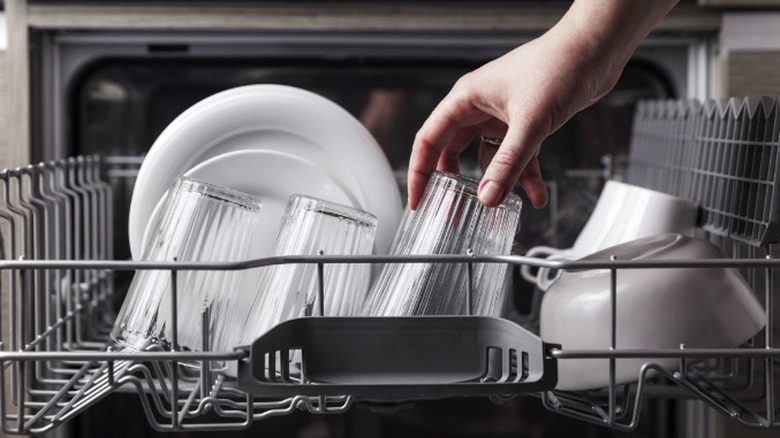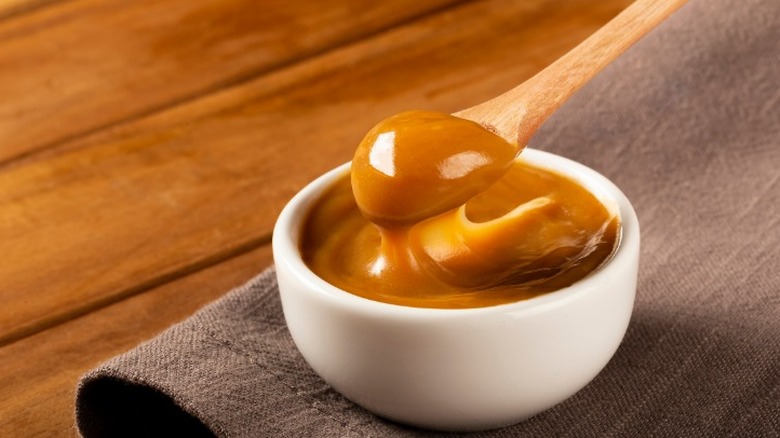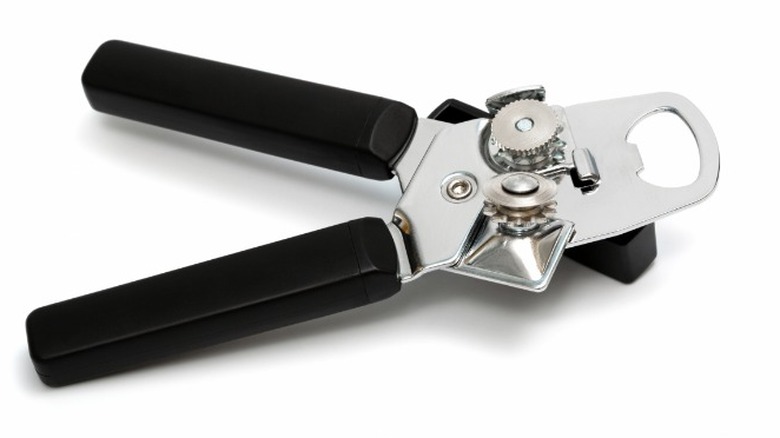12 Food Hacks That Turned Out To Be Dangerous
Finding little shortcuts for things we do in ordinary life can be a thrilling discovery. These tips and tricks are often called life hacks, and they usually introduce novel ways to complete tasks, ranging from beauty tips to woodworking projects. Cooking presents endless opportunities to employ life hacks that make your food easier to prepare and lead to better results. Furthermore, social media also offers endless cooking hacks that may use questionable practices and lead to less-than-stellar results.
Life hacks can be useful, but they can also be dangerous. A 2018 USDA study revealed that a surprising number of Americans spread bacteria in the kitchen without being aware of it. CDC estimates show 9,338,075 instances of infection from 31 pathogens in a year in the U.S., based on 2006 population figures.
Also, the National Fire Protection Association estimates that home cooking results in an average of 172,900 fires in the country. Cooking can be dangerous and potentially lead to injury and illness. We all have to be vigilant when cooking, which means food hacks should be vetted before they are tried. The people on TikTok or Instagram may not have your safety in mind while they are chasing clicks. That's why it is important to protect yourself and avoid some of the more dangerous hacks out there.
1. Slow thawing
When you're preparing a meal that involves one out of many different choices of meat, it's best to have it thawed and ready to cook. The USDA only lists four approved methods for thawing meat safely. Meat can be left in the refrigerator until thawed. It can also be left under running cold water until ready. Thawing in the microwave is acceptable. And meat can be thawed by cooking it directly from frozen, as in placing frozen burger patties directly on a hot grill. These are the only safe ways to thaw meat safely.
That said, some people will try a shortcut. It may seem like smart planning to set some chicken breasts out on the counter while at home on a lunch break, expecting them to be ready for the pan after returning from work. You really do not want to do this as it presents a huge opportunity for bacteria to grow.
Thawing meat on the counter allows the temperature of the meat to remain in the danger zone for too long. Food that reaches more than 40 degrees Fahrenheit and is not brought up to more than 140 degrees Fahrenheit within two hours should not be served, as the danger of a foodborne illness remains high even after the food is eventually cooked. Stick to the four approved methods to prevent illnesses.
2. Deep-fried turkey
Every November, you likely hear stories about how someone in your social circles has tried deep-fried turkey. Indeed it can be a delicious way to prepare the traditional Thanksgiving fowl. While deep-fried turkey can be tasty, the process can be quite dangerous.
Frying a turkey usually requires a purpose-built fryer meant for a turkey and a large volume of oil. One of the arguments for frying a turkey is the cooking time, as it only takes 30 to 45 minutes, and the turkey typically comes out quite juicy and tender.
Turkey frying tends to be responsible for a lot of pain on Thanksgiving: According to Newsweek, fried turkeys cause 60 injuries, five deaths, and $15 million in property damage on average each year. The issue is that a large vat of hot oil must be handled with care as it can cause horrible burns to people but is also easily ignited if a spill occurs near a flame.
A violent explosion from introducing a frozen or only partially thawed turkey into the hot oil is also another cause of holiday meal disasters: Scores of videos of disasters can be found online. It may be best to stick to the oven if you are not familiar with this method. But if you decide to fry, take it slow and use this guide to ensure you do not ruin the holiday.
3. Toaster cooking
Most people are familiar with using a toaster. Toasters have been a fixture in the modern kitchen for decades. Toasters present a versatile way of preparing a huge variety of foods. There are several food hacks online that use toasters. But you may not necessarily want to use them.
One popular cooking hack has been making the rounds on the video sharing sites for the last couple of years, making it all the way to a Gordon Ramsay reaction video and Rhett and Link trying this trick on Good Mythical Morning.
The hack is, if nothing else, elegant in its simplicity, and it works exactly how you would think. You simply take your favorite cut of beef and put it in the toaster as though it was your favorite sourdough. Rhett claims that running the toaster through four cycles results in a perfect medium rare. But you shouldn't try it.
The problem here is that a good steak will drip grease as it cooks, which is bound to make a mess. But, more importantly, toasters use exposed electric heating elements to cook, and it is just way too easy for some delicious au jus to drip down your ribeye as the fat renders onto the heating element, resulting in a near-instant grease fire that can just as easily morph into an electric fire.
4. Engine cooking
Old-timer gearheads and survivalists have shared this little cooking morsel for eons and spread it far and wide long before the existence of social media or the internet. Basically, it entails taking some kind of meal, which could involve fish, steak, or even kebabs, and wrapping it in some good quality heavy-duty aluminum foil.
Once the ready-to-cook meal has been thoroughly wrapped, stick it on the intake manifold of your favorite classic American car with a V8 engine, drive ten or so miles, and pull over for lunch. That really does sound easy, right?
Engines produce a lot of heat, and the temperature inside an engine can run hundreds to thousands of degrees, and that dissipating heat can be transferred to a meal as you drive. Honestly, this will work, although controlling the heat is out of the question. The amount of heat will cook the food as long as the drive is long enough. Gordon Ramsay used his Range Rover to cook a sea bass on an outing with his family, and the food allegedly tasted quite good.
The key to using this hack safely is ensuring that the car is in impeccably good condition, as many hazards are lurking under the hood. Dangers to the food include having petroleum products seep into the meal as well as exhaust or gas fumes. If the food is improperly placed, it can affect the operation of the engine, potentially causing a crash, and no kebab is worth that risk.
5. Pasta colander hack
Another trend that is making the rounds lately may leave you dumbfounded as you feel that you have been draining the pasta wrong your whole life. You may wonder how much of a need there is for this hack, as draining pasta is pretty elementary. Yet it exists anyway.
The traditional method is to cook pasta in a pot in boiling water until tender. Once it is ready, pour everything into a colander, preferably located in the sink. The new millennium variation on the old standard, as seen in countless videos, is to place the colander in the pot dome side down, then grab both pot and colander and turn them upside down over the sink to drain the boiling water. The main benefit of doing this seems to be saving about two seconds.
So yes, this hack does work. However, it significantly increases the chance of scalding your hands. In most of the videos, hot pads are used to grab both colander and pot, but cloth pads will soak up the water quickly and transfer that heat straight to your hand. So, if you happen to slip or become distracted, you scald your hands. Also, if the colander doesn't fit just right, it can slip out, and you burn your hands. This hack just presents many ways to scald your hands to save a couple of seconds: It hardly seems worth it.
6. Dishwasher cooking
Anyone who is familiar with this trend may know that it dates back to at least 2013 when it was featured on an episode of TLC's Extreme Cheapskate. In one episode, Stephanie, who has a penchant for penny-pinching (to absurd heights), uses a dishwasher to cook lasagna.
This is definitely unorthodox, and others YouTubers have since experimented with this method to varying results. Since dishwashers use heat to help ensure dishes come out clean and sanitized, it is plausible this will work.
Despite any plausibility, it is highly discouraged by the Association of Home Appliance Manufacturers. The potential hazards include the inability of the dishwasher to completely destroy harmful bacteria, such as E. coli and salmonella, as the temperature in the food does not rise more than 140 degrees Fahrenheit.
Furthermore, no matter how much you may work to ensure a perfect seal, the pressures and agitation of the dishwasher can break it, possibly introducing soap into the food. Furthermore, bits of food can end up on the heating element and cause a fire. Most of all, it's an inefficient use of energy.
This hack also made it onto Mythbusters, who tried an experiment to see just how well they could get a lasagna to turn out from a dishwasher. While they managed to get it up to temperature after cooking (washing?) for three hours, results from an oven would have been faster and better.
7. Torch wine opener
While most people use a traditional corkscrew to open a bottle of wine, some people insist on using another way. Someone has come up with the option of using fire to open a wine bottle. The idea behind this hack is to use the torch to heat the air trapped within the bottle so that it will expand and push the cork out of the bottle.
Air expands when heated, so this should work theoretically. It also works in practice when performed by a skilled hand. But not everyone with a bottle of wine possesses a skilled hand. Here's the rub. To accomplish this trick properly, one should use a small butane torch like you might see used to finish a creme brulee.
A few years ago, the Daily Mail reported on some poor lad who used a handheld MAPP gas torch, which is something you might see in an auto repair shop, resulted in a small explosion of the bottle neck, sending glass shards flying in all directions.
8. Soda can popcorn
Most people who have used YouTube have probably come across a channel called "5-Minute Crafts." This channel puts out loads of videos showing myriad ways to decorate things, create fun projects, along with a ton of different life hacks. It is so popular that many copy and mimic the channel to varying degrees of success. The hacks from these videos are largely silly and useless, but some of them can be downright dangerous.
That is the case regarding the hack demonstrated by a Chinese YouTuber who created a video showing how to make popcorn using a soda can. It involved cutting the can open to use as the cooker and placing it on an apparatus over a fire. When the bottom of the can heats up, the popcorn comes bursting out and falls into a bowl.
Yet, two teenage girls in China attempted to recreate this, and both ended up in the hospital with serious burns. In the video, an alcohol burner is set up to use for the heat, and when these young girls tried this, it exploded, sending burning alcohol and oil all over them. Sadly, one of them was burned so badly that she died in the hospital, while the other one had to undergo traumatic burn recovery. This serves as a sad reminder to use common sense when trying new ideas and not to trust everything you see online.
9. Omelet in a bag
There are many different ways to cook an egg. Eggs are highly versatile, and they contribute to many an array of recipes too numerous to count, including desserts, sauces, casseroles, and more. Yet, a plain cooked egg remains a breakfast staple in the U.S., and it can be cooked in several different ways, such as the omelet.
Enter the omelet in a bag: Some TikToks show this egg shortcut in which the user cracks an egg or two into a zippered bag and adds some traditional ingredients, such as ham and cheese. Then, they drop the bag into a pot of boiling water, and a fully cooked omelet emerges a few minutes later. It's really more like scrambled eggs in a bag rather than an omelet, but who's counting?
Should you try this? Maybe. The boiling water will ensure the eggs are fully cooked, but the dangers of toxins leaking from the plastic bag are concerning. Ziplock claims its bags are free of Dioxin and BPA, which should make them safe.
However, the melting point of some plastic bags is around 140 degrees Fahrenheit, well below the boiling point of water. The dangers of this hack are not definitive, but making an omelet in a pan might actually be easier and take less time, so maybe skip the omelet in a bag at your next breakfast.
10. Easy dulce de leche
Dulce de leche is a classic staple of Latin American dessert. It's made by cooking milk and sugar at low heat over a long period of time. It's used to flavor sweet breads, candies, and drinks throughout the Hispanic world, and it is delicious. However, it takes a long period of time to cook, which can lead some to look for a shortcut, and some folks think they may have found it.
However, it might just be better to pick up some readymade sauce at the supermarket. The shortcut involves boiling a can of sweetened condensed milk. This shortcut goes back a long time: In 1985, the Orlando Sentinel published a warning from dairy producer Borden not to heat cans of condensed milk in boiling water or the oven.
Regardless, this method calls for the can to be set into boiling water until the contents become caramelized. It is said that if you can oversee the entire procedure and not leave it unattended, it can be done safely. This method is particularly dangerous when opening as the can is still hot, and the increased pressure can send a thick and gooey substance flying and potentially cause some nasty burns. It may be better just to find your local Mexican bakery.
11. Garlic peeling hack
Food prep is a labor of love. Some of the best dishes are also the most complicated and labor-intensive. Just preparing fresh garlic can be a thankless and time-consuming task, but a world without garlic is no world to live in at all. So that leaves some to try to beat the system and figure out a better, faster, and easier way to do it, including Chrissy Teigen.
Teigen shared a tweet in which she was apparently blown away by this hack: the original tweet she was replying to is gone. Basically, instead of going through the arduous process of peeling away the skin of the garlic and smashing the cloves to release the good meat inside, you can take a paring knife and insert it into each individual clove and twist them out. The trick is to twist the clove after inserting the knife, and it will slide right out with no hassle and mostly no mess.
June Xie of Delish tried this method, but her experience did not live up to the expectations set by the hack video. Pieces of garlic broke off while the knife failed to remove anything whole. Perhaps this could be accomplished with the right knife and a bit of practice. But for the average novice home cook, it is more likely to end up with an abundance of Band-Aid wrappers on the counter.
12. Can opener
While the can opener has been around for a while, it would not be invented for 50 years after the can. The basic design of the can opener has also not changed much since the 1920s when the familiar rotary blade cutter opener was patented. Still, there have been improvements to the 1920s design and otter innovations to come along, such as the electric can opener. Most of these have been created to make life easier, but you may not know there are more ways than one to use the old design.
According to this can-opening hack, you are meant to believe you have been using this old and trusty device incorrectly for years. But have you? Videos going around show people opening cans with the opener turned 90 degrees with the cutter now piercing the side of the can rather than the top. It appears this works, but why? If you think it's to open up more opportunities for you to cut yourself, you would be correct.
Using the opener in this fashion leaves sharp edges on the can and makes it easier to cut yourself on the cutter itself. When used in the traditional manner, the cutter sits below the edge of the can and cuts down into the top, leaving the sharp edges down and away from the surface. So, you are welcome to use a can opener any way you choose, but remember that you have, in fact, been doing it right all along.
